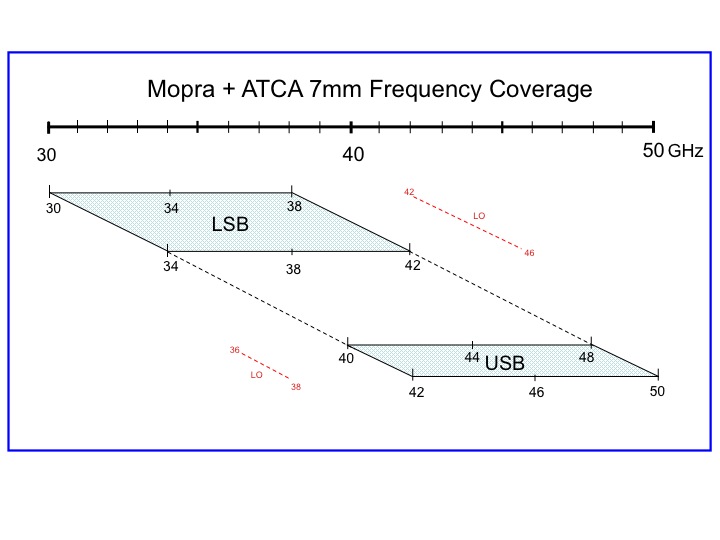ATCA@7mm
System Specs
1. Permitted observing frequencies
The Compact array allows simultaneous observing in two polarisations at each of two frequencies. For 7-mm observations, the centres of the two observing bands must both be in the range 30 to 50 GHz; additionally, the two frequencies are required to be at most 2.7 GHz apart and have integer MHz values.
This 2.7 GHz restriction in separation is set by the bandwidth of the current ATCA 6 and 3cm band conversion, which the 7mm receivers are fed into. This restriction will be removed with the Compact Array Broad Band upgrade (CABB) where full 8GHz separation in the two frequencies will be possible. CABB will replace the current system in March 2009.
Be aware that observations at 7-mm require a translation of the mm receiver package. When switching to and from the 7-mm system please allow ~10 mins overhead time.
Additional information for CABB ATCA and Mopra 7-mm observations
The figure illustrates the frequency coverage of the 7-mm observing band on ATCA and Mopra. Every frequency from 30 to 50 GHz is observable, but with some limitations. There are hardware limitations in the LO chain that have resulted in limitations in the tuning ranges for CABB. The tuning ranges (specified as the band centre) are:
34 to 38 GHz
44 to 46 GHz
At any frequency within these ranges the full 8-GHz frequency coverage is possible. The gap between 38 to 44 GHz cannot be processed as one frequency setting.
For example, when tuned to 38 GHz your frequency band will cover the range 34 to 42 GHz. When tuned to 44 GHz the frequency band will cover the range 40 to 48 GHz. However, one cannot have a band containing 38 to 44 GHz.

2. Permitted observing bandwidths with the system until March 2009
Either or both frequencies can have bandwidths of 64 or 128 MHz. The first frequency can have a narrow bandwidth of 4, 8, 16 or 32 MHz. See the list of available correlator configurations in the ATCA users guide to determine the appropriate frequency to tune the ATCA correlator.
3. Field of View
The FWHM of the antenna primary beam is 1.45 arcmin at 35 GHz and 1.26 arcmin at 40 GHz. MIRIAD's task pbplot will return the size of the ATCA primary beam (in arcmin) at your exact observing frequency.
4. Polarisation
Dual linear. The system provides IFs that correspond to orthogonal linear polarizations. The X and Y polarizations correspond to E-fields at P.A. 45 and -45 degrees with respect to the vertical.
5. Vane/Paddle
Unlike the ATCA 3mm system, the 7mm system uses an atmospheric model to correct for atmospheric attenuation.
6. Sideband Rejection
Poor rejection of the second sideband image has been identified in 7mm ATCA data. It is also probably an issue for high frequencies (above 100GHz). Some frequencies should be better protected against this problem. For continuum observations at 7mm we recommend 34496/34624 or 44096/44224 as the observing frequencies. For more information, talk to the Duty Astronomer.
 
website maintained by: Kate Brooks
